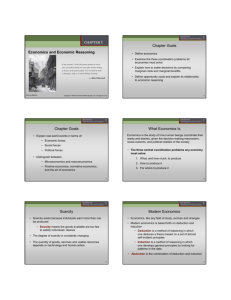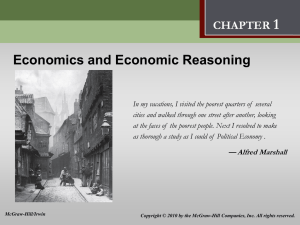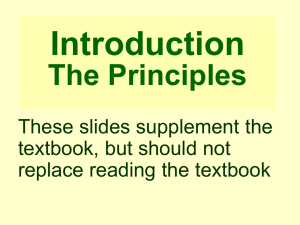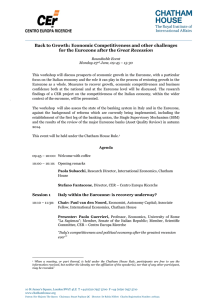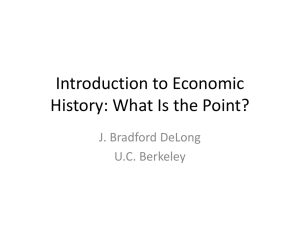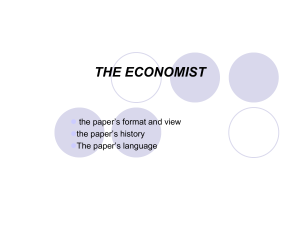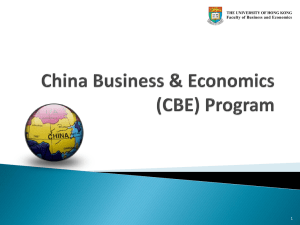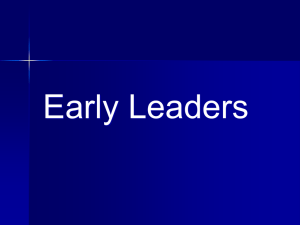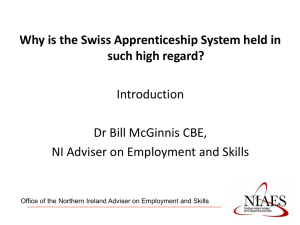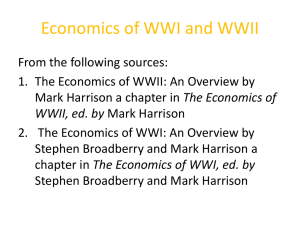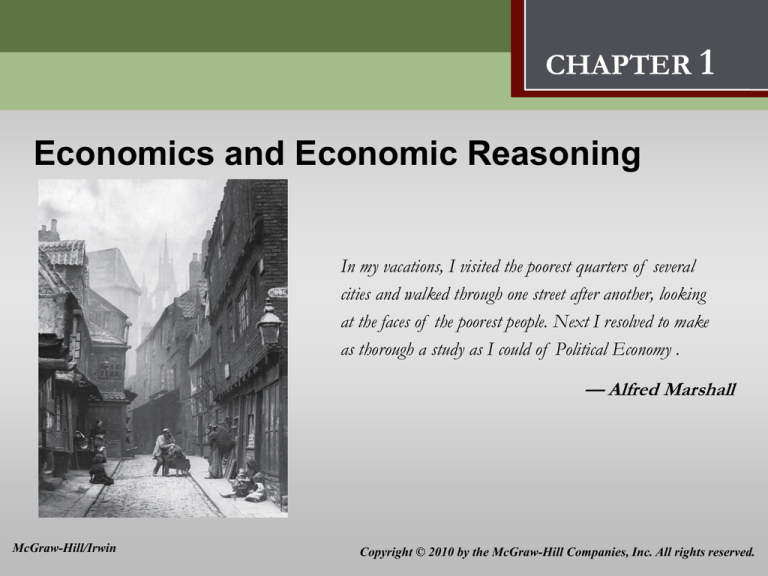
Introduction:
Thinking Like an Economist
1
CHAPTER 1
Economics and Economic Reasoning
In my vacations, I visited the poorest quarters of several
cities and walked through one street after another, looking
at the faces of the poorest people. Next I resolved to make
as thorough a study as I could of Political Economy .
— Alfred Marshall
McGraw-Hill/Irwin
Copyright © 2010 by the McGraw-Hill Companies, Inc. All rights reserved.
Introduction:
Thinking Like an Economist
1
Chapter Goals
• Define economics
• Examine the three coordination problems all
economies must solve
• Explain how to make decisions by comparing
marginal costs and marginal benefits
• Define opportunity costs and explain its relationship
to economic reasoning
1-2
Introduction:
Thinking Like an Economist
1
Chapter Goals
• Explain real-world events in terms of:
• Economic forces
• Social forces
• Political forces
• Distinguish between:
• Microeconomics and macroeconomics
• Positive economics, normative economics,
and the art of economics
1-3
Introduction:
Thinking Like an Economist
1
What Economics Is
Economics is the study of how human beings coordinate their
wants and desires, given the decision-making mechanism,
social customs, and political realities of the society
• The three central coordination problems any economy
must solve:
1. What, and how much, to produce
2. How to produce it
3. For whom to produce it
1-4
Introduction:
Thinking Like an Economist
1
Scarcity
• Scarcity exists because individuals want more than can
be produced
• Scarcity means the goods available are too few
to satisfy individuals’ desires
• The degree of scarcity is constantly changing
• The quantity of goods, services and usable resources
depends on technology and human action
1-5
Introduction:
Thinking Like an Economist
1
Modern Economics
• Economics, like any field of study, evolves and changes
• Modern economics is based both on deduction and
induction
• Deduction is a method of reasoning in which
one deduces a theory based on a set of almost
self-evident principles
• Induction is a method of reasoning in which
one develops general principles by looking for
patterns in the data
• Abduction is the combination of deduction and induction
1-6
Introduction:
Thinking Like an Economist
1
A Guide to Economic Reasoning
An example of the economic decision rule:
• Steve Levitt’s bestseller, Freakonomics, contains many
examples of “thinking like an economist”
• Levitt uses economic reasoning to explain why
people become drug dealers
• The potential financial benefit of selling drugs is
much higher than the cost of giving up a
minimum wage job
1-7
Introduction:
Thinking Like an Economist
1
Marginal costs and marginal benefits
• Using economic reasoning, decisions are often made by
comparing marginal costs and marginal benefits
• Marginal cost is the additional cost over and
above costs already incurred
• Marginal benefit is the additional benefit above
and beyond what has already accrued
1-8
Introduction:
Thinking Like an Economist
1
Marginal costs and marginal benefits
The economic decision rule:
• If the marginal benefits of doing something exceed the
marginal costs, do it.
MB > MC Do it!
• If the marginal costs of doing something exceed the
marginal benefits, don’t do it.
MC > MB Don’t do it!
1-9
Introduction:
Thinking Like an Economist
1
Opportunity Cost
• Opportunity cost is the benefit forgone of the next-best
alternative to the activity you have chosen
• Opportunity cost should always be less than the benefit
of what you have chosen
• Opportunity cost is the basis of cost/benefit economic
reasoning
1-10
Introduction:
Thinking Like an Economist
1
Opportunity Cost
Examples of opportunity cost:
1. Individual decisions
• The opportunity cost of college includes:
• Items you could have purchased with the
money spent for tuition and books
• Loss of the income from a full-time job
2. Government decisions
• The opportunity cost of money spent on the war
on terrorism is less spending on health care or
education
1-11
Introduction:
Thinking Like an Economist
1
Economic and Market Forces
• Economic forces are mechanisms that ration scarce goods
• A market force is an economic force that is given
relatively free rein by society to work through the market
• The invisible hand is the price mechanism that guides
our actions in a market. The invisible hand is an example
of a market force.
• If there is a shortage, prices rise
• If there is a surplus, prices fall
1-12
Introduction:
Thinking Like an Economist
1
Economic and Market Forces
• What happens in society can be seen as a reaction to,
and interaction of:
• Economic forces
• Social forces
• Historical forces
• Social, cultural, and political forces influence market
forces
• Political and social forces often work together against
the invisible hand
1-13
Introduction:
Thinking Like an Economist
1
Economic Terminology
• Goal of this class is to describe how economics works
in the real world
• You will be introduced to many terms that occur in
business and in discussions of the economy
• For example:
• Opportunity cost
• Marginal benefit and marginal cost
• The invisible hand
• Market and economic forces
• … and many more
1-14
Introduction:
Thinking Like an Economist
1
Economic Insights
• Theories tie together economists’ terminology and
knowledge about economic institutions
• Theories are too abstract to apply in specific cases and
are often embodied in economic models and principles
• An economic model is a framework that places
the generalized insights of the theory in a more
specific contextual setting
• An economic principle is a commonly held
insight stated as a law or general assumption
1-15
Introduction:
Thinking Like an Economist
1
Economic Insights
• Theories, models, and principles are continually tested
to see of the predictions of the model match the data
• Models lead to…
• theorems (propositions that are logically true
based on the assumptions of the model)…
• to arrive at policy precepts (policy rules that
conclude that a particular course of action is
preferable)
• These theorems must be combined with knowledge of
real-world economic institutions and value judgments
to determine economic goals for society
1-16
1
Introduction:
Thinking Like an Economist
The Invisible Hand Theory
• According to the invisible hand theory, a market
economy, through the price mechanism, will allocate
resources efficiently
• Prices fall when quantity supplied is greater than
quantity demanded
• Prices rise when the quantity demanded is greater
than the quantity supplied
• Efficiency means achieving a goal as cheaply as possible
1-17
Introduction:
Thinking Like an Economist
1
Microeconomics and Macroeconomics
• Economic theory is divided into two parts;
• Microeconomics is the study of individual choice,
and how that choice is influenced by economic
forces
• Macroeconomics is the study of the economy
as a whole
1-18
Introduction:
Thinking Like an Economist
1
Microeconomics and Macroeconomics
• Microeconomics studies such things as:
• The pricing policy of firms
• Household’s decisions on what to buy
• How markets allocate resources among
alternative ends
• Macroeconomics studies such things as:
• Inflation
• Unemployment
• Economic growth
1-19
Introduction:
Thinking Like an Economist
1
Economic Institutions
• To apply economic theory to reality, you've got to have
a sense of economic institutions
• Economic institutions are laws, common practices,
and organizations in a society that affect the economy
• Economic institutions differ significantly among nations
• They sometimes seem to operate differently than
economic theory predicts
1-20
Introduction:
Thinking Like an Economist
1
Economic Policy Options
• Economic policies are actions (or inactions) taken by
the government to influence economic actions
• Objective policy analysis keeps value judgments
separate from the analysis
• Subjective policy analysis reflects the analyst’s views
of how things should be
1-21
Introduction:
Thinking Like an Economist
1
Economic Policy Options
Objective Policy Analysis
• To distinguish between objective and subjective analysis,
economics is divided into three categories
1. Positive economics is the study of what is
2. Normative economics is the study of what
should be
3. Art of economics is using the knowledge
of positive economics to achieve the goals
determined in normative economics
1-22
Introduction:
Thinking Like an Economist
1
Chapter Summary
• Three coordination problems are what to produce,
how to produce it, and for whom to produce it
• Scarcity exists
• Modern economists use abduction
• Economic reasoning structures all questions in a
cost/benefit framework
• Opportunity costs exist
1-23
Introduction:
Thinking Like an Economist
1
Chapter Summary
• Economic, political, and social forces are always
at work
• Under certain conditions, the market, through the price
mechanism, will allocate scarce resources efficiently
• Economics is divided into micro and macroeconomics
• Precepts are the guides for policies based on theorem
• Economics can be subdivided into positive economics,
normative economics, and the art of economics
1-24
Introduction:
Thinking Like an Economist
1
Preview of Chapter 2:
The Production Possibility Model, Trade, and Globalization
• Demonstrate opportunity cost with a production
possibility curve
• Discuss the increasing marginal opportunity cost
• Relate the concept of comparative advantage to the
production possibility curve
• Show how through comparative advantage and trade, a
country can consume beyond their production possibility
• Explain how globalization and outsourcing are part of a
global process guided by the law of one price
1-25

